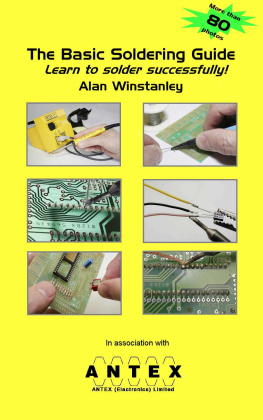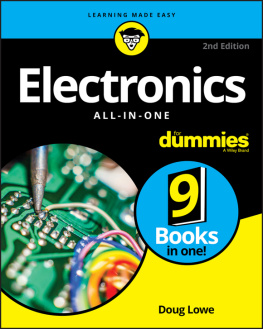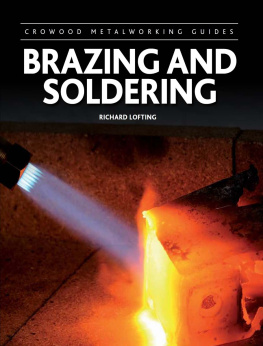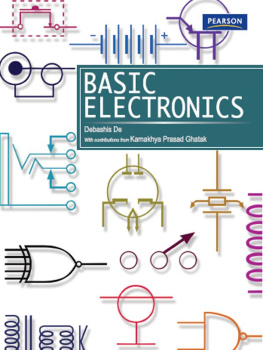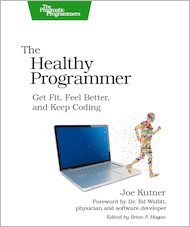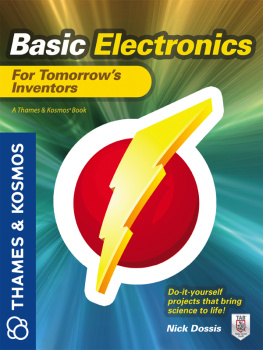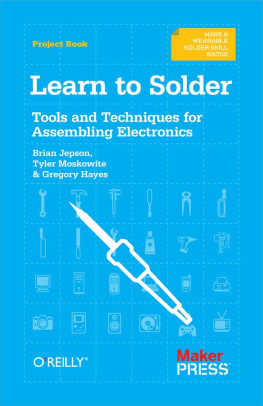Winstanley - Basic Soldering Guide Handbook - Learn to solder electronics successfully
Here you can read online Winstanley - Basic Soldering Guide Handbook - Learn to solder electronics successfully full text of the book (entire story) in english for free. Download pdf and epub, get meaning, cover and reviews about this ebook. year: 2013, genre: Home and family. Description of the work, (preface) as well as reviews are available. Best literature library LitArk.com created for fans of good reading and offers a wide selection of genres:
Romance novel
Science fiction
Adventure
Detective
Science
History
Home and family
Prose
Art
Politics
Computer
Non-fiction
Religion
Business
Children
Humor
Choose a favorite category and find really read worthwhile books. Enjoy immersion in the world of imagination, feel the emotions of the characters or learn something new for yourself, make an fascinating discovery.
- Book:Basic Soldering Guide Handbook - Learn to solder electronics successfully
- Author:
- Genre:
- Year:2013
- Rating:3 / 5
- Favourites:Add to favourites
- Your mark:
- 60
- 1
- 2
- 3
- 4
- 5
Basic Soldering Guide Handbook - Learn to solder electronics successfully: summary, description and annotation
We offer to read an annotation, description, summary or preface (depends on what the author of the book "Basic Soldering Guide Handbook - Learn to solder electronics successfully" wrote himself). If you haven't found the necessary information about the book — write in the comments, we will try to find it.
Winstanley: author's other books
Who wrote Basic Soldering Guide Handbook - Learn to solder electronics successfully? Find out the surname, the name of the author of the book and a list of all author's works by series.
Basic Soldering Guide Handbook - Learn to solder electronics successfully — read online for free the complete book (whole text) full work
Below is the text of the book, divided by pages. System saving the place of the last page read, allows you to conveniently read the book "Basic Soldering Guide Handbook - Learn to solder electronics successfully" online for free, without having to search again every time where you left off. Put a bookmark, and you can go to the page where you finished reading at any time.
Font size:
Interval:
Bookmark:

All text, diagrams and photographs areCopyright 1996-2013 A. R. Winstanley. All Rights Reserved.
All text, diagrams and photographsare fully protected by copyright and may not be reproduced in any commercial ornon-commercial publication or medium, mirrored on any commercial ornon-commercial website nor may they be appended to or amended, monetised orused or re-distributed for any commercial reason, without the prior permissionof the writer.
Every care has been taken to ensurethat the information and guidance given is accurate and reliable, but sinceconditions of use are beyond the writers control no legal liability orconsequential claims will be accepted for any errors contained herein.
Where mentioned, the U.K. mainsvoltage supply is 230V a.c. and you should amend ratings for your localconditions.
In 1996 when the world wide web was still very young, Ilaunched the first and most detailed website ever describing the practicalskills of electronic soldering, and my BasicSoldering Guide quickly became the #1 web site of its kind in the Googlesearch engine.
Thanks to its in-depth reference text and the unequalledhigh-quality close-up photography showing soldering step by step, many quickly learnedthe essential stages needed to make a solder joint successfully. Even noviceswho had never tried soldering before, gained the skills and confidence neededto acquire this skill.
My Basic Soldering Guide became a key go-to online guidefor soldering, and Ive enjoyed receiving encouraging feedback ever since fromthe likes of the US Air Force, US Marines, US Coastguard, Honeywell trainers,Atomic Energy authorities, Australian aeronautical suppliers, UK colleges anduniversities, trainees and many more around the world.
In association with Antex (Electronics) Ltd., the leading UKmanufacturer of electronic soldering equipment, Im delighted to bring you thisupdated Basic Soldering Guide containing over 80 all-new colour photographs, morebackground, more detailed information and lots more practical hints and tips.
Ive revisited various areas of the guide and refreshedthem, taking onboard readers queries and nearly 17 years of online feedback, experiencesand answering readers questions. With the help of all-new photography, Imsure youll master the skills needed to solder electronics successfully using thisupdated guide.
I welcome feedback and comments, and readers can reach mevia my website
Alan Winstanley
July 2013
The first and most important aspect of assembling anyelectronic project is that of soldering, which is a delicate and preciseskill that can be mastered with experience. Sometimes called soft soldering,theres no shortcut to acquiring the necessary expertise, and producing aconsistently satisfactory solder joint takes a little practice. However, likeriding a bicycle, soldering is an art which once learnt is never forgotten, andthe purpose of this new and updated guide is to explain the techniques ofsoldering and desoldering for beginners, which I hope will set the hobbyist or traineetechnician firmly on the road to successful electronic assembly or repairs inthe future.
Soldering is the least aggressive way of joining non-ferrousmetals together, and is used universally in electronics, air conditioning andrefrigeration circuits, household plumbing and more besides applicationswhere the precise joining together of components at fairly moderatetemperatures is needed. Further up the scale, brazing involves usinghigher temperatures to melt brazing rods onto larger metal parts, perhaps to repaira metal chair, lawnmower or to fabricate metal components or jewellery intointricate shapes. Lastly, welding is a very aggressive way of fabricationusing welding rods or wire; steel girders, oil rigs and ships are all weldedtogether, or robotic spot-welding is used for the mass production of, say, washingmachines or car bodyshells using sheet steel to make strong rigid assemblies.
Due to the lower temperatures used and the need to makeconsistently good electrically conductive and mechanically sound joints withprecision, soldering is used to connect components together when manufacturingelectronic circuits. Small components would quickly be destroyed by brazing orwelding, although tiny spot-welding joints do appear in electronics, perhaps toweld a metal tag onto a button battery.
This guide therefore deals with the soldering techniquesused in electronics at hobbyist or trainee educational level. It explains whatto look for before buying a soldering iron, describes ways of making various solderjoints on circuit boards and other electronic components, and also how to desolder removing solder in order to repair a circuit board or replace an electroniccomponent.
Youll also find more details of other aspects of soldering,including an outline of typical solder types and fluxes. In short, everythingyou need to get started in electronics soldering is here, so lets get started!
The principle behind soldering sounds quite simple: the ideais to join components together to form an electrical connection, by using amixture of lead and tin solder or alternatively lead-free solder (an alloy oftin and copper), which is melted onto the joint using a soldering iron.If you have never picked up a soldering iron before, then this guide will showyou everything to help you start soldering with confidence. I also hope thatthe guidance will help those working in other areas computer technicians oraudio enthusiasts, for example, who may be faced with electronic repairs ormodifications using a soldering iron for the first time.
If youre an electronics hobbyist or trainee, beforeembarking on any form of ambitious electronic project, it is recommended thatyou practice your soldering technique on some brand new components usingclean strip board (or protoboard) or a printed circuit board, and selecta simple and straightforward constructional design as a starting point. Becomeacquainted and comfortable with your chosen soldering iron, which likely tobecome as familiar to you as a favourite pen. Learn how to balance it and handleit with precision. Try soldering an assortment of resistors, capacitors,diodes, transistors and integrated circuits with it, and then try your hand at desoldering removing the solder again to make a repair or modification.
A really good place to start learning is by building asimple electronics kit, such as a Velleman kit that contains a good qualityprinted circuit board. Youll learn some of the basic skills of successfulsoldering this way, and itll be a great confidence booster too.
Did you know? In the USA and elsewhere, the letter L insolder is silent and they say soda or sodder but here in Britain we dopronounce the L and we say sole-der.
Search any electronics catalogue or website and youll see abewildering array of soldering equipment on sale, including irons, controllers,work stations and desoldering equipment too. A large range of soldering ironsis readily obtainable - which one is suitable for you depends on your budgetand how serious your interest in electronics is, but theres something forevery pocket distributed by a variety of retail, industrial and mail-orderoutlets.
Font size:
Interval:
Bookmark:
Similar books «Basic Soldering Guide Handbook - Learn to solder electronics successfully»
Look at similar books to Basic Soldering Guide Handbook - Learn to solder electronics successfully. We have selected literature similar in name and meaning in the hope of providing readers with more options to find new, interesting, not yet read works.
Discussion, reviews of the book Basic Soldering Guide Handbook - Learn to solder electronics successfully and just readers' own opinions. Leave your comments, write what you think about the work, its meaning or the main characters. Specify what exactly you liked and what you didn't like, and why you think so.

